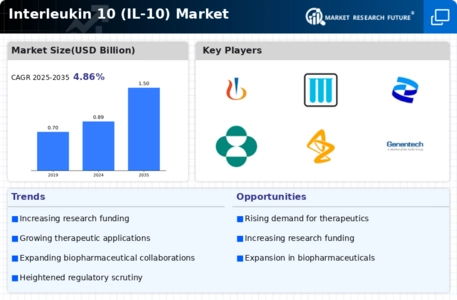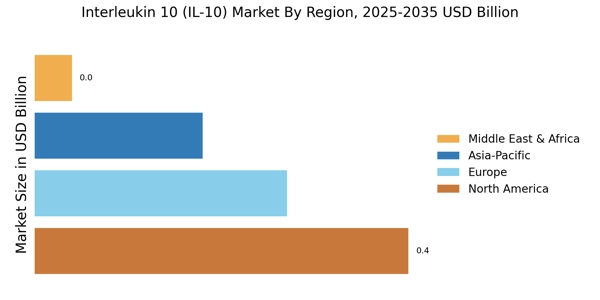Advancements in Biotechnology
Technological advancements in biotechnology are significantly influencing the Interleukin Market 10 (IL-10) Market. Innovations in genetic engineering, monoclonal antibody production, and recombinant DNA technology are enhancing the development of IL-10-based therapies. These advancements facilitate the creation of more effective and targeted treatments, which are crucial for managing various inflammatory and autoimmune disorders. The market for biopharmaceuticals, including IL-10 therapies, is projected to grow substantially, with estimates suggesting a compound annual growth rate of over 10% in the coming years. As biotechnology continues to evolve, it is expected to unlock new therapeutic potentials for IL-10, thereby attracting investments and fostering collaborations among pharmaceutical companies and research institutions.
Regulatory Support for Biologics
Regulatory bodies are increasingly supportive of biologics, including Interleukin Market 10 (IL-10) therapies, which is a significant driver for the market. Streamlined approval processes and incentives for developing biologics are encouraging pharmaceutical companies to invest in IL-10 research. Recent regulatory frameworks have been established to expedite the development of biologics, particularly those targeting unmet medical needs. This supportive environment is likely to enhance the market's growth, as companies can bring IL-10 therapies to market more efficiently. Furthermore, the emphasis on patient-centric approaches in regulatory policies aligns with the therapeutic potential of IL-10, which aims to improve patient outcomes in various inflammatory and autoimmune conditions.
Growing Investment in Immunotherapy
The increasing focus on immunotherapy as a treatment modality is driving the Interleukin Market 10 (IL-10) Market. Immunotherapy has emerged as a promising approach for various cancers and chronic diseases, with IL-10 playing a crucial role in modulating immune responses. The Interleukin Market 10 (IL-10) is anticipated to reach over USD 200 billion by 2025, reflecting a robust interest in harnessing the immune system for therapeutic purposes. IL-10's ability to enhance immune tolerance and reduce inflammation positions it as a valuable candidate in this landscape. As more clinical trials and studies are initiated to explore IL-10's efficacy, the market is likely to witness increased activity, with pharmaceutical companies investing in research and development to capitalize on this trend.
Rising Demand for Targeted Therapies
The shift towards personalized and targeted therapies is reshaping the Interleukin Market 10 (IL-10) Market. Patients and healthcare providers are increasingly seeking treatments that are tailored to individual needs, which enhances the efficacy and safety of therapies. IL-10, with its specific immunomodulatory effects, is being investigated for its potential in personalized medicine approaches. The market for targeted therapies is expected to grow significantly, with projections indicating a value exceeding USD 150 billion by 2026. This trend is likely to drive research into IL-10 applications across various diseases, as the demand for precision medicine continues to rise. As healthcare systems evolve, the integration of IL-10 into targeted treatment regimens may become more prevalent, further propelling market growth.
Increasing Prevalence of Autoimmune Diseases
The rising incidence of autoimmune diseases is a pivotal driver for the Interleukin Market 10 (IL-10) Market. Conditions such as rheumatoid arthritis, lupus, and multiple sclerosis are becoming more prevalent, necessitating innovative therapeutic solutions. Research indicates that autoimmune diseases affect approximately 5-8% of the population in various regions, leading to a heightened demand for effective treatments. IL-10, known for its anti-inflammatory properties, is being explored as a potential therapeutic agent. This growing patient population is likely to stimulate investments in IL-10 research and development, thereby propelling the market forward. Furthermore, the increasing awareness and diagnosis of these conditions contribute to the market's expansion, as healthcare providers seek advanced therapies to manage symptoms and improve patient outcomes.


















Leave a Comment